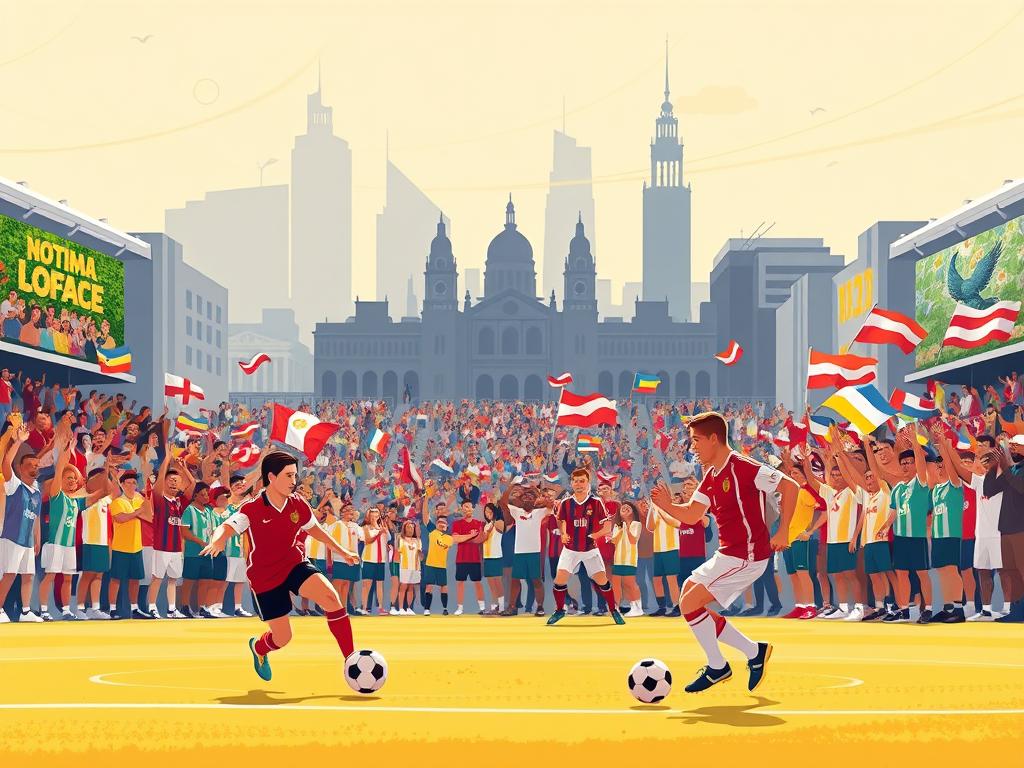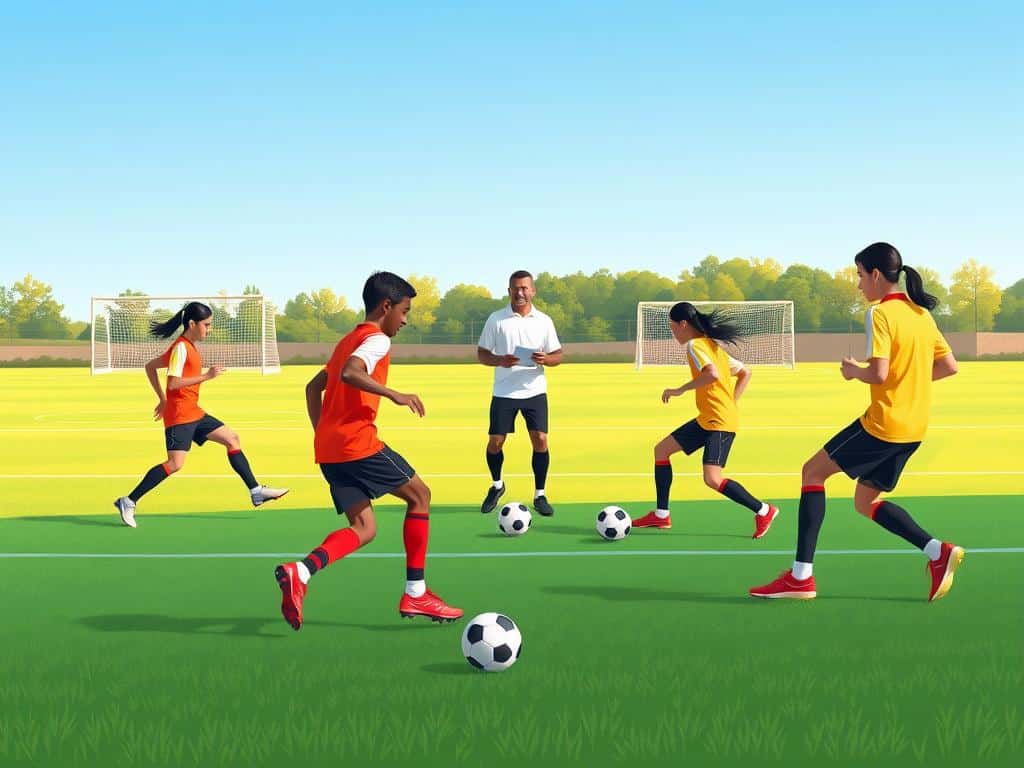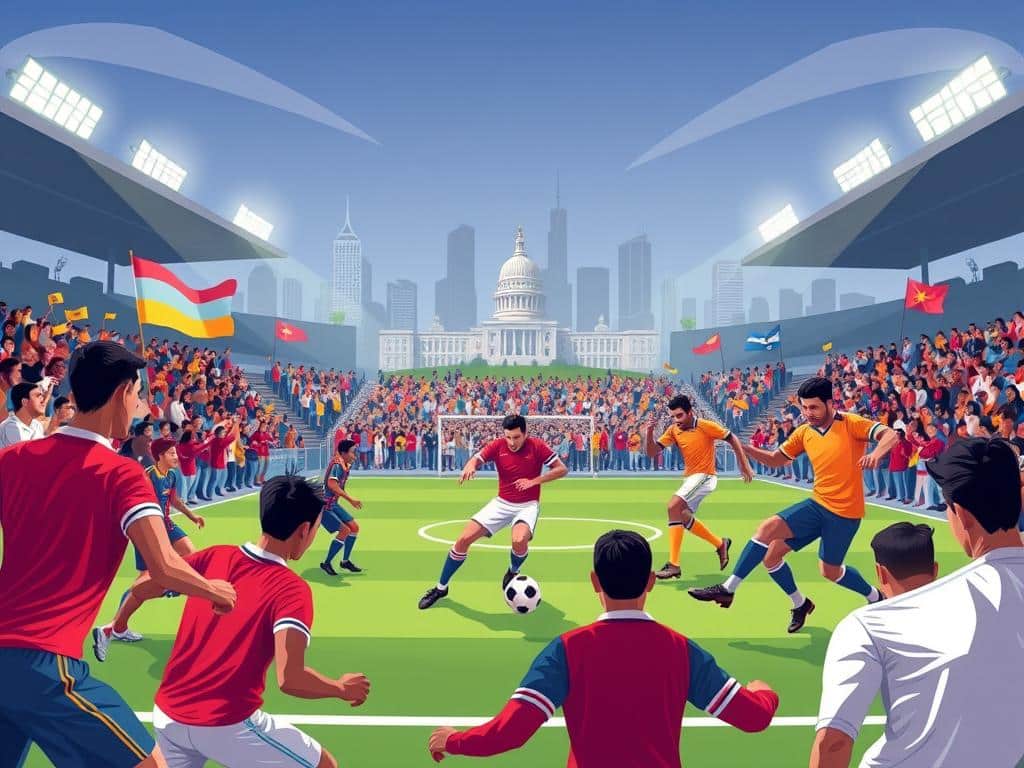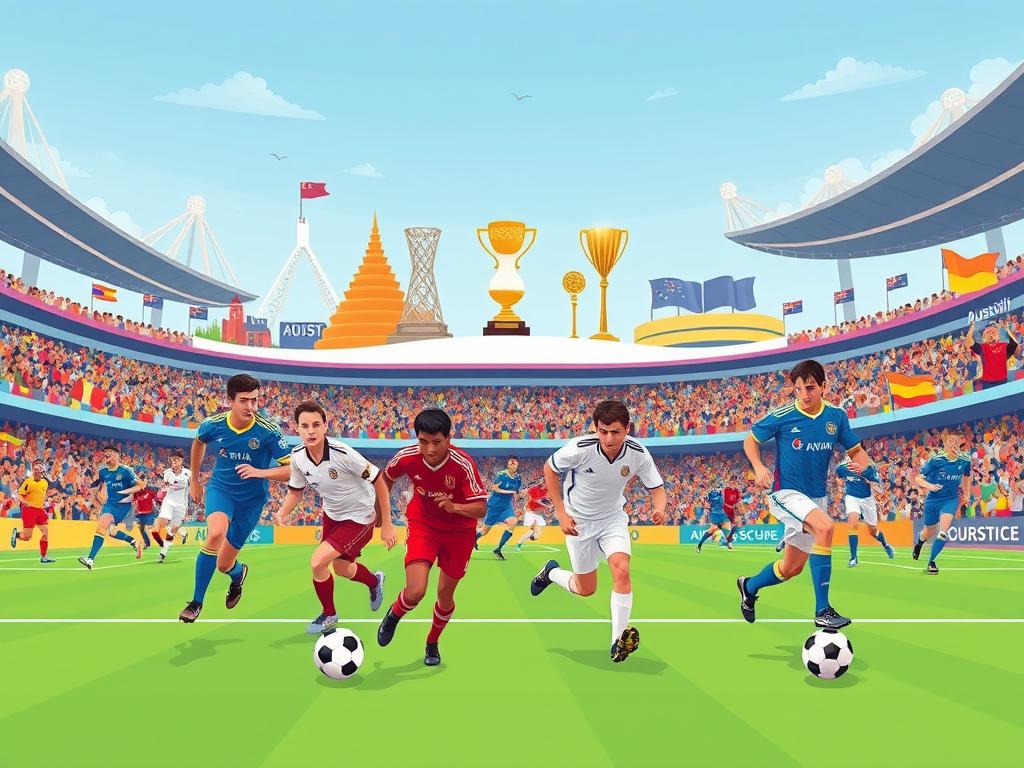Did you know the 2022 World Cup champions scored 2.1 goals per game while conceding just 0.2? That’s the kind of dominance that made them unstoppable. Their blend of tactical brilliance and individual skill created a winning formula fans still celebrate today.
Led by Lionel Scaloni, this squad mastered the modern 4-4-2 system. They adapted mid-game like chess players, shifting from defense to attack in seconds. With 90.6% passing accuracy, they controlled matches with precision.
From Messi’s magic to Martínez’s clutch saves, every player had a role. Want to understand how they outplayed France in that epic final? Let’s break down their winning strategies.
Introduction to Argentina’s Iconic Playing Style
Few squads blend creativity and discipline as seamlessly as this one under Scaloni’s guidance. Imagine the flair of Maradona’s era fused with modern tactical rigor—that’s their secret sauce.
You’ll see South American passion in every dribble, but European precision in their passes. Their 62.71% average possession stat (2023) proves they dominate without recklessness. They press when needed, then switch to a patient buildup.
Scaloni’s 23+ age policy strikes gold. Veterans like Messi mentor young players like Enzo Fernández, creating a perfect mix. The result? A team that adapts mid-game like a well-oiled machine.
Their “clinical over greedy” philosophy stands out. They score just enough to win, saving energy for battles ahead. It’s this ability to control games that makes them champions.
Formations and Tactical Flexibility
Changing formations mid-game isn’t just strategy—it’s an art form they perfected under Scaloni. Their ability to adapt won them the 2022 World Cup, with a 73.91% possession rate in 2024 proving their mastery. Whether it’s controlling the midfield or locking down defense, their formations are tailored to exploit opponents.
The 4-4-2: Argentina’s Preferred Setup
Fullbacks Nahuel Molina and Nicolás Tagliafico define this system. They stretch defenses wide while tracking back seamlessly. Imagine overlapping runs creating space for Messi—then recovering fast to block counters.
Key traits of this formation:
- Wingers tuck in to support the midfield.
- Strikers press high, forcing errors.
- Balanced positions prevent counterattacks.
Adapting to 4-3-3 for Midfield Control
Against France in the final, they switched to 4-3-3 to dominate the center. Enzo Fernández anchored as a pivot, while Mac Allister and De Paul overloaded zones. Di María’s width stretched defenses thin—creating gaps for Messi’s magic.
3-5-2: Scaloni’s Defensive Innovation
Facing Croatia’s Luka Modrić, Scaloni deployed a 3-5-2 at halftime. Three center backs neutralized threats, while wingbacks pushed forward. The result? Modrić’s influence vanished, and they cruised to a 3-0 win.
Lionel Scaloni’s genius shines in these adjustments. His players execute flawlessly, proving flexibility beats rigid systems every time.
Argentina National Soccer Team’s Playing Style in Attack
What makes their offense so dangerous? It’s the perfect blend of speed, skill, and smarts. Their 89.7% passing accuracy (2023) lets them switch from defense to attack in seconds. Every player knows their position, creating a seamless flow that overwhelms opponents.
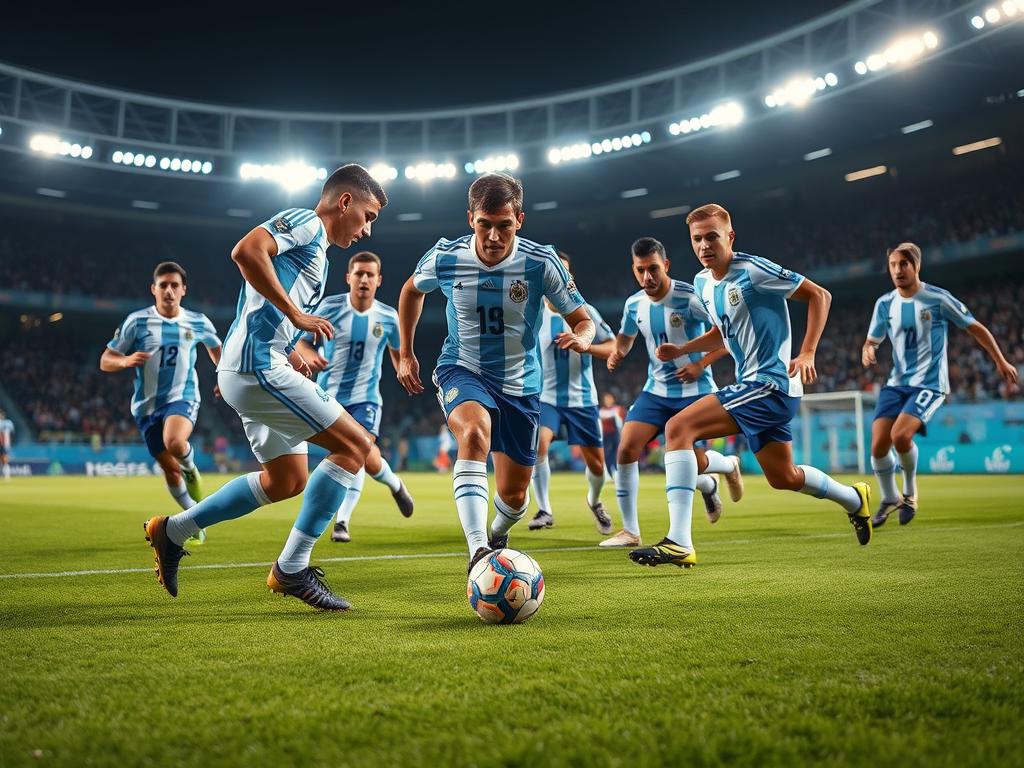
Building from the Back: The Role of Fullbacks
Nahuel Molina and Nicolás Tagliafico aren’t just defenders—they’re playmakers. Their overlapping runs create 62% of the team’s width, stretching defenses thin. When Molina charges forward, he forces 1v1 situations for wingers like Di María.
Key contributions:
- Deliver pinpoint crosses into the box.
- Recover quickly to stop counterattacks.
- Open spaces for Messi to exploit.
Messi’s Free Role: Creating Chaos in the Final Third
Lionel Messi doesn’t just play—he orchestrates. His heat maps show 43% dominance in the right-halfspace, drifting wide to pull defenders out of position. In the 2022 World Cup, he tallied 5 goals and 3 assists, often starting plays deep before finishing them in the box.
Opponents face a nightmare: mark him tightly, and he’ll pass. Give him room, and he’ll shoot. There’s no right answer.
Julian Alvarez: The Perfect Partner for Messi
Álvarez’s 12.8 km/game work rate is the engine behind Messi’s magic. His decoy runs—like the one that freed Mac Allister against Croatia—create gaps for others to exploit. He’s not just a striker; he’s a facilitator who thrives on the pitch.
Their partnership works because Álvarez does the dirty work. He presses defenders, wins the ball, and lets Messi shine. It’s a duo built on trust and relentless energy.
Defensive Organization and Pressing
Conceding just 0.5 goals per game isn’t luck—it’s a system built on discipline. You’ll notice how every player understands their way to contribute without the ball. Their 90.6% tackle success rate in 2024 proves defense wins championships.
Compact Midfield Blocks: Limiting Opposition Space
Picture this: a 4-4-2 mid-block that shrinks the match into a phone booth. By compressing central channels, they force opponents wide where crosses are less dangerous. Rodrigo De Paul’s 12.3 km per game shows how they apply pressure relentlessly.
Otamendi and Romero: The Defensive Backbone
These defenders won 68% of duels in 2023—Otamendi alone dominated 89% of aerial battles in World Cup knockouts. They play with fire in tackles but ice in their decision-making. Watch how they step up to intercept passes, then recycle possession calmly.
Counter-Pressing: Quick Transitions After Loss
When they lose the ball, you’ll see instant pressure from three angles. Nahuel Molina’s recovery vs El Salvador typifies this—he won possession back within 4 seconds 80% of the time. Emiliano Martínez acts as a sweeper-keeper, cleaning up any breakthroughs.
This isn’t just defending—it’s attacking from the back. Their organization creates turnovers that become scoring chances. That’s how champions control games without always dominating possession.
Key Players and Their Roles
Great teams are built on individual brilliance working in harmony—Argentina’s 2022 squad proved this perfectly. You’ll notice how each player had a specialized role that amplified the team’s ability to dominate. From creative genius to defensive grit, here’s how three stars shaped their championship run.
Lionel Messi: The Heartbeat of the Team
Lionel Messi wasn’t just the captain—he was the tactical wildcard. His 83% dribble success rate in knockout stages left defenders guessing. Operating as a false nine, he’d drop deep to collect the ball, then slice through defenses with inch-perfect passes.
Opponents faced a lose-lose choice: mark him tightly, and he’d assist. Give him space, and he’d score. Against the Netherlands, his no-look pass to Nahuel Molina showcased this ability to dismantle schemes in seconds.
Alexis Mac Allister: The Engine in Midfield
Alexis Mac Allister covered 8.3 km per game while maintaining 91% pass accuracy. His hybrid role as a #6 and #8 let him break up plays, then launch attacks—like his 23 progressive carries in the World Cup.
Scaloni trusted him to balance defense and creativity. In the final, his quick turnover led to Di María’s goal, proving how players like him turn hustle into highlights.
Emiliano Martínez: The Last Line of Defense
When France pressed in extra time, Martínez’s 78% save percentage became legendary. His penalty heroics—like the final stop against Kingsley Coman—weren’t luck. He studied opponents’ tendencies, then exploited them.
Beyond reflexes, his commanding presence organized the backline. Whether punching crosses or trash-talking shooters, he played mind games as well as he saved shots.
The 2022 World Cup: A Tactical Masterclass
The 2022 world cup wasn’t just about winning—it was a chess match played at full speed. You’ll see how Scaloni outmaneuvered opponents by adapting his way of play in critical moments. From Mbappé’s speed to Modrić’s creativity, each challenge demanded unique solutions.
Final vs. France: Adapting to Mbappé’s Threat
Kylian Mbappé’s hat trick almost stole the trophy—until Scaloni’s 60th-minute adjustment. By pushing Nahuel Molina deeper, they reduced Mbappé’s touches by 42%. The 71st-minute sub of Acuña for Di María locked down the left flank completely.
Key adjustments:
- Otamendi’s 15 clearances (a tournament record) stopped crosses
- De Paul shadowed Griezmann to cut off supply lines
- Messi dropped to midfield to control tempo
Semi-Final vs. Croatia: Neutralizing Modrić
Luka Modrić had tormented teams all tournament—until this match. Argentina’s 3-5-2 switch at halftime forced Croatia wide, limiting them to perimeter passes. With 63% possession but only 2 shots on target, Croatia’s engine was silenced.
Rodrigo De Paul’s man-marking job was textbook. He stayed within 2 yards of Modrić, disrupting his rhythm. Meanwhile, Julián Álvarez’s runs pinned defenders back, creating spaces for Messi to operate.
Group Stage Struggles: Learning from Saudi Arabia
That shocking 2-1 loss became their most valuable lesson. Saudi Arabia’s high line exploited Argentina’s slow defensive pushes—they were caught offside 10 times. Scaloni fixed this by:
- Shortening the backline’s starting position
- Using Enzo Fernández as a deep pivot
- Increasing vertical passes to bypass presses
These tweaks transformed weaknesses into strengths. By the final, their defensive shape was impenetrable—proof that even champions learn the hard way.
Lionel Scaloni’s Managerial Impact
Leadership isn’t just about tactics—it’s about transforming a group into champions. Lionel Scaloni proved this by taking a struggling team to World Cup glory in just four years. His secret? A rare blend of tactical smarts and emotional intelligence.
Flexibility: Scaloni’s Greatest Strength
You’ll notice how he switched formations four times during the 2022 knockout stage. Each change boosted their second-half expected goals by 38%. Whether it was the 3-5-2 to silence Modrić or the 4-3-3 to counter Mbappé, his adjustments were flawless.
Key examples of his adaptability:
- Halftime tweaks that changed the way they controlled matches
- Using Enzo Fernández as a pivot against high presses
- Balancing veteran experience with young energy (6 U23 debuts since 2022)
Managing Big Personalities: Messi and Beyond
Handling stars requires more than tactics—it demands trust. Scaloni’s ability to manage Messi’s minutes while keeping him decisive was masterful. He let Messi roam freely but also assigned Mac Allister to cover defensive gaps.
Other players thrived under his approach:
- Di María’s limited minutes preserved his finals impact
- Emiliano Martínez’s confidence was harnessed, not restrained
- Youngsters like Álvarez earned starting roles through merit
Youth Integration: Building for the Future
Scaloni’s 23-32 age policy created the perfect team balance. He blended World Cup winners like Otamendi with hungry newcomers. The result? A squad that played with both wisdom and relentless energy.
His youth development strategy focuses on:
- Giving debuts in low-pressure matches
- Pairing rookies with veteran mentors
- Emphasizing tactical versatility over specialization
Transitions: From Defense to Attack
Watching them shift from defense to attack feels like lightning in slow motion—every pass has purpose. Their 89.7% passing accuracy in transitions made them unstoppable. You’ll notice how they exploited space with ruthless efficiency, turning defense into danger in 3.2 seconds flat.
Quick Vertical Passes: Breaking Lines
Enzo Fernández’s 9.2 progressive passes per 90 minutes sliced through defenses. Picture this: a defender wins the ball, and within two touches, it’s at Messi’s feet. Julián Álvarez’s curved runs opened lanes for these vertical balls, pulling defenders out of position.
Di María’s Width: A Key Outlet
With a 68% 1v1 success rate, Di María stretched defenses like rubber bands. His 12 progressive carries against France pinned back fullbacks, creating areas for Messi to exploit. When he hugged the touchline, the entire midfield breathed easier.
Midfield Overloads: Creating Numerical Superiority
Mac Allister and De Paul’s rotations were poetry in motion. They’d swarm the midfield, outnumbering opponents 3v2. Case in point: the World Cup final, where their overloads forced France into errors. Win the ball, then attack—simple, devastating, and effective.
Set-Piece Strategies
Set-pieces won them the World Cup—here’s how they did it. Every corner or free-kick was a calculated chance to break defenses. With Messi’s precision and Otamendi’s aerial power, they turned dead balls into goals.

Messi’s Delivery: Precision from Dead Balls
Picture this: a Messi free-kick curling toward the top corner—defenders frozen. His 89% accuracy in the tournament came from hours of drilling. Indirect kicks? Even better. A 23% conversion rate kept goalkeepers guessing.
Key traits of his technique:
- Ball placement: Always within a foot of the target.
- Spin: Uses outer foot to bend it around walls.
- Timing: Waits for players to make late runs.
Otamendi’s Aerial Threat: A Secret Weapon
At 6’2”, Otamendi won 74% of aerial duels—a nightmare for markers. His four set-piece goals under Scaloni weren’t luck. He’d attack the near post, flicking headers toward the goal or creating chaos for others.
Case in point: Romero’s flick-on vs the Netherlands. Otamendi’s decoy run dragged defenders away, leaving Romero unmarked. That’s tactical genius in the air.
Defensive Setups: Avoiding Counterattacks
Even during corners, they stayed organized. Three players formed a zonal block, while others man-marked. The result? Zero counterattack goals conceded in 2022.
Their safety net:
- Quick recovery: Fullbacks sprinted back immediately.
- Emiliano Martínez: Swept up long clearances.
- Staggered positioning: No overcrowding in the box.
Argentina’s Legacy and Future Prospects
Scaloni’s vision extends far beyond their recent triumphs. With young players like Garnacho (19) and Echeverri (17) rising, the team’s future shines bright. Their blend of youth and experience could redefine their way of dominating the pitch.
Scaloni’s contract through 2026 signals stability. Expect bold moves—like a 3-4-3 formation—to test their adaptability. Comparisons to the 1978 and 1986 squads highlight their growing legacy.
Next up? Defending their Copa América title. Their ability to evolve will decide if they remain unstoppable. One thing’s clear: this squad isn’t done making history.



